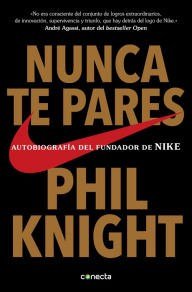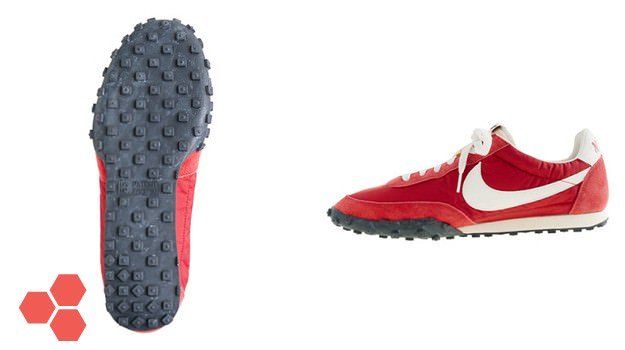This post contains spoilers about the book. If you plan to read it (the book), DO NOT CONTINUE reading (this post).
I just read the book Never Stand Up, Nike's birth story told by co-founder Phil Knight. To start with, the translation can be improved. Especially the title. The original is called Shoe Dog, which better reflects the spirit of the book. It is difficult for me to understand how they have arrived at such a free and unfocused translation. Someone enlightened in some marketing department who probably hasn't read it to you.

Never stop is the story of Nike novel by one of its founders: Phil Knight. The story covers everything from the crazy idea of a 20-year-old to the IPO in December 1980. My feeling is that I needed to tell, share, explain the most intense experience of his life that is the creation of Nike. It is not a book of management in use, but from which many lessons can be learned from the process of creating and managing companies: My reflections after reading:
Creating a business is a high-risk activity, but it makes sense for a lifetime.
It's an emotional roller coaster ride. Knight recounts the many vicissitudes he had to go through during the creation stage of Nike: economic problems, unfair employees, distribution contracts that are not respected, supply problems that prevent satisfying demand, dirty play by competitors, problems with the American government, etc. A race full of obstacles that never end. It seems impossible to have three months of peace of mind in a row. It's anything but easy. So if you are going to start the adventure of creating your own company, keep in mind that it is exhausting, exhausting but very rewarding.
Every day there were fifty new problems, fifty difficult decisions that had to be made right there, and we were always well aware that a false step, a bad determination, could mean the end.
It's not for everyone, even if now it seems that if you're not an entrepreneur, you're not a successful person.
What about those who encourage entrepreneurs never to give up? Charlatans. Sometimes you have to give up. Sometimes you have to know when to do it and try something else, that's genius. Giving up doesn't mean stopping. Never stop."
Personal and professional balance when trying to create a company like Nike is simply not possible
Knight comments on some aspects of his personal life but without going into detail as he does with his company. Personal life in this book is a collateral for understanding context. Creating a company is absorbing from all points of view, mainly mental and time. In Knight's case he had to travel constantly to Japan where he started manufacturing and then to the rest of the USA and the world. So it is impossible that personal life and the relationship of a couple do not suffer. Today technology helps us "stretch time" and allows us to be in two places at once, but mentally you're still focused on growing your "baby. It is a choice with many pros and cons.
Passion for the product
Knight and his partner Bill Bowerman were obsessed with sports and especially athletics. Bowerman was one of the greatest track and field coaches of all time. A legend with many Olympic medallist pupils. For Bowerman, sports equipment was critical to the success of his athletes. And slippers the key element. He was always experimenting to improve the shoes available on the market. I was devising solutions to improve the grip on the ground, make them lighter, whatever it took to get a tenth of a second off the clock. It was what is now called a hacker. He wore slippers and tested them with his runners. And not always successfully. He invented the groft-shaped sole. An innovation that is still valid and improved the grip on the new material with which the athletics tracks began to be manufactured (rubber and rubber) at the end of the sixties. A real revolution.

Knight, on the other hand, was one of Bowerman's pupils at the University of Oregon (where the brand originated and still has headquarters) and his favorite guinea pig to test his latest inventions. Both lived with intensity in athletics and knew that running shoes were a key element in a runner's performance. This fascination leads them to be innovative and constantly trying new things. Prior to Nike, Adidas was the world leader among many other shoe manufacturers. Nike was a revolution by raising the bar thanks to the constant innovation of its products from people who knew how to improve their sneakers. Without this innovation as a result of their in-depth knowledge of the activity, they would not have succeeded.
"Bowerman often snooped around our lockers and sneaked away our shoes. He spent days tearing it apart, sewing it again, and then returning it with some small modification, which either made us run like fallow deer, or made us bleed. Whatever the results, it never stopped. I was determined to find new ways to reinforce the instep, cushion the midsole, give more space to the forefoot. I always had some new design, some new plan to make our slippers more elegant, softer, lighter.
Lack of money is a company's most likely cause of death
The book recounts the company's continuing financial problems, to the point that they were on the verge of closing several times. And it was not a product problem, but quite the opposite. The Nike liked them and they sold very well. The problem was that they were growing very fast and couldn't find funding. The passages that describe the negotiation with the banks and the arrogant and empathetic attitude of the bankers are very topical.
"It was Wallace who made net worth a fetish and despised growth. Ruggedly built, thug-faced and a Nixon-type bearded shadow, Wallace was ten years older than me, but somehow believed he was the prodigy child of the bank. He was also determined to become the next president of the bank, and saw all credit default risks as the main obstacle between him and that objective. Far less he liked to give credit to anyone, but with my balance sheet always hovering around zero, I saw myself as an eventual disaster always on the verge of happening. A bad season, a decline in sales, and it would break, the hallway of Wallace's bank would be filled with unsold slippers, and the holy grail of the bank presidency would slip out of his hands.
The book is a constant agony for finding funding to achieve positive "Net Worth". The problems are over when they make the decision to go public, much to their regret. Becoming a public company is an option they have always rejected in order not to lose freedom. Money gives you peace of mind but takes away your freedom.
Brand and luck
One awaits the application of the scientific method to choose the name and logo of one of the world's most renowned brands. He imagines a contest with the most famous advertising agencies, design, branding of the moment with the aim of conceptualizing a logo as simple as a ticker but that becomes a contemporary icon. Long brainstorming sessions to choose a simple, short, hard to forget name. So far from reality. Both the name and logo are an accident.
Whatever, I was read it till the end 😅
Downvoting a post can decrease pending rewards and make it less visible. Common reasons:
Submit